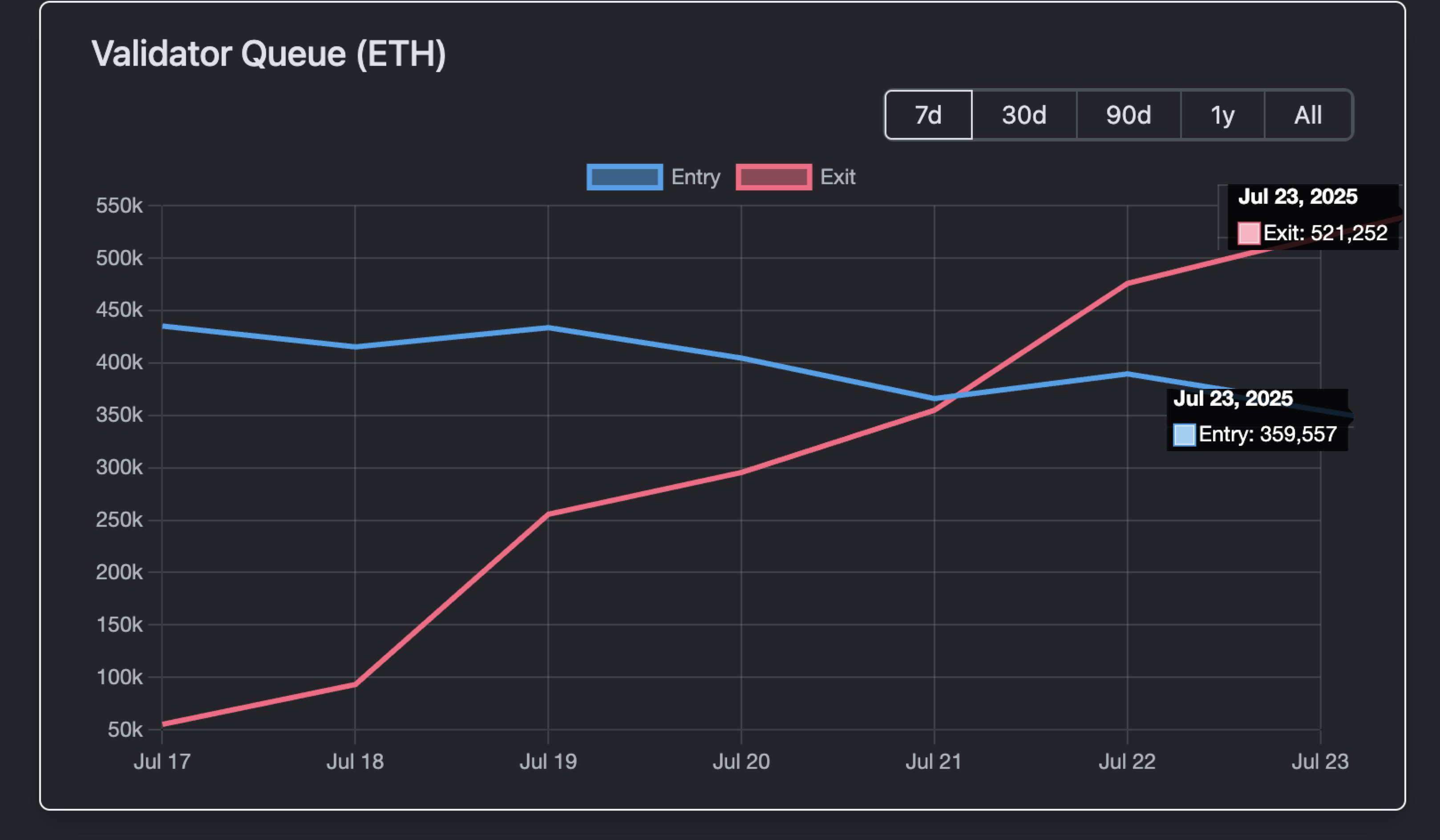Original author: TechFlow
Whenever the market is good, FUD is inevitable.
Today, a piece of news made everyone worry about the price of ETH again:
Validators of the Ethereum network are queuing up to release their staked ETH.
As a representative of the PoS consensus mechanism, staking ETH is technically used to maintain the security of the entire Ethereum network, and economically it can also obtain additional income generated by staking, locking the liquidity of ETH in the staking pool.
However, according to data from Validator Queue, as of July 23, the Ethereum validator exit queue had accumulated about 521,252 ETH that was being unstaked, with a current value of about US$1.93 billion. The waiting time for unstaking was more than 9 days and 1 hour.
This is also the longest queue that validators have waited in when choosing to withdraw in the past year.
Since each validator usually stakes 32 ETH, theoretically this is equivalent to more than 16,000 validators seeking to exit the stake. The large-scale queue to choose to unstake makes people smell some dangerous air.
Taking profits?
Are the whales and institutions going to sell ETH to take profits?
The surge in Ethereum unstacking may be partly related to the recent price increase.
Since the low point in early April 2025 (about $1,500-2,000), ETH has experienced a strong rebound, with a cumulative increase of 160% so far. Specifically, on July 21, ETH hit a high of $3,812, which is the peak in the past seven months.
Such rapid rises often prompt some investors to take profits, especially early stakers who may decide to lock in profits rather than continue holding after seeing the gains.
From a historical perspective, this pattern is not new.
From January to February 2024, when the ETH/BTC ratio rose by 25% in a week, a similar wave of unstaking occurred, causing a short-term price drop of 10%-15%. However, it was also around the same time that Celsius went bankrupt and liquidated, and 460,000 ETH were unstaked in a short period of time, causing a queue congestion of about a week for the entire ETH network validator exit queue.
Not selling pressure
Unlike before, although the queue for ETH unstacking is long and the amount to be unstaked is large this time, it does not mean direct selling pressure.
First of all, looking at the data from the Validator Queue, on July 23, there were 520,000 ETH queued for unstacking, but at the same time, 360,000 ETH entered the staking queue.
The two factors offset each other, and the net withdrawal of ETH from the Ethereum network will be greatly reduced.

Secondly, institutional behavior also plays a certain buffering role.
Data from July 22 showed that the total inflow of ETH spot ETFs of various institutions in the open market reached US$3.1 billion, which was significantly larger in absolute value than the 520,000 ETH (US$1.9 billion) that queued for unstacking on the same day.
And this is just one day’s net ETF inflow, not to mention that there is still a 9-day queue period for validators to exit the queue.
At the same time, releasing the pledge does not necessarily mean it will be sold.
In the context of this round of ETH rise, the concentrated unpledging is also likely due to the adjustment of institutions custody services or the shift to crypto treasury strategies . To put it more clearly, it is to change the custody of ETH to seek more profits, rather than selling ETH.
On the chain, some of the unstaked ETH is more likely to be used for DeFi and NFT related activities. For example, it is used as collateral to provide liquidity, or there were whales sweeping the floor of Crypto Punks yesterday;
In addition, the LST tokens on the chain often depeg, which also provides arbitrage opportunities for ETH---for example, the ratio of stETH to ETH has recently fallen to 0.996 (a discount of about 0.04%), and weETH has also experienced similar fluctuations. Arbitrageurs profit by buying discounted LST and waiting for the restoration of the 1:1 peg, which increases the demand for ETH.
Overall, the unstaking is more like an internal adjustment of the Ethereum ecosystem rather than a direct selling signal.
However, there are also various speculations on social media. Although the concentrated release of pledges does not mean selling pressure, it is very likely to point to a phenomenon, namely changing the dealer.
Some people believe that BlackRock, which is committed to promoting crypto assets into the mainstream financial circle, has become the de facto big market maker of ETH. As of July, BlackRock has accumulated more than 2 million ETH (worth approximately US$6.9-8.9 billion), accounting for about 1.5%-2% of the total supply of ETH (approximately 120 million ETH).
This is not a secret, but a public ETF asset management behavior, so it is more like an institutional-level open market - promoting the institutional adoption of ETH through public holding and accumulation of ETFs, rather than manipulating the market.
The logic behind the change of dealers is that when Ethereum transforms from a value consensus within the circle to a financial instrument consensus in a broader sense, it is a very obvious trend that Wall Street will take over and prepare to make a big move.
This speculation is not without reason. Pledging and unpledging may also be a transformation of the chip structure.
But in any case, Ethereums growth potential will continue to support its leadership in the crypto field, and this wave of unstaking may just be the starting point of a new cycle.










